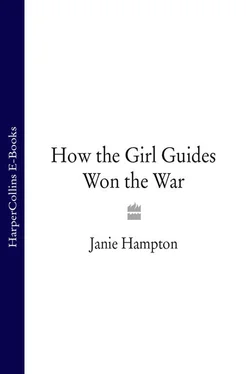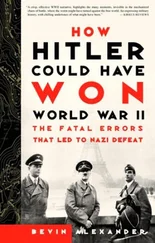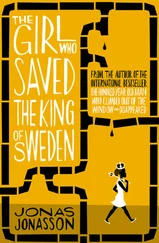JANIE HAMPTON
How the Girl Guides Won the War
To my mother, who throughout her long life as both
a Guide and a Brown Owl, has demonstrated that
keeping to the rules is not nearly as
important as Robert Baden-Powell’s maxim:
‘I wouldn’t give tuppence for you if you are not jolly and laughing.’
Cover
Title page JANIE HAMPTON How the Girl Guides Won the War
Illustrations
Introduction
Prologue: Pax Ting
1 We are the Girl Scouts
2 Brownies and Bluebirds
3 Marching in Gas Masks
4 Kinder-Guides
5 Golondrinas
6 The Clover Union of Poland
7 Blackout Blues
8 Dampers and Doodlebugs
9 Brownies in China
10 Thrift and Gift
11 Princesses and Paupers
12 Baedeker Bombing
13 Jersey Island Guides
14 Japanese Internment
15 The Warsaw Uprising
16 Three Aunties
17 Guides in Auschwitz
18 Giant Pandas and Frozen Alligators
19 The City of Polish Children
20 The Armored Angel of China
21 The Army of Goodwill
22 Into the Twenty-First Century
Acknowledgements
Bibliography and Sources
Index
Copyright
About the Publisher
Robert Baden-Powell talking to the first Girl Guides in Brighton, 1910. (© Girlguiding UK)
Guide messengers at the Peace Conference, Versailles, 1919. (© Daily Mail )
Olave Baden-Powell, with Brownies at the Essex County Rally in 1921. (© Girlguiding UK)
Guides enjoying an excursion on the Danube during the Pax Ting International Camp in Hungary, August 1939. (© Girlguiding UK)
Guides helping at a club for evacuees in the Corn Exchange at Bishop’s Stortford in autumn 1939. (© Getty Images)
The 1st Eynsham Brownie Pack on holiday in Swanage in the last week of August 1939. (Private collection)
Guides learning how to use a stirrup pump in 1940. (© Girlguiding UK)
Guides help to run an infant school in Ilford. (© Getty Images)
Guides bathing an evacuee child. (© Girlguiding UK)
The vicar of Claybury Park, Ilford, Essex asked Guides to run a nursery in his church hall, 1940. (© Girlguiding UK)
Olga Malkowska being presented with the Bronze Cross by Queen Elizabeth in December 1939. (© Getty Images)
Brownies of the 21st Glasgow Brownie Pack, at the Glasgow School for the Deaf, meet a real Brown Owl. (© Girlguiding UK)
Cockley Cley Kindertransport Guides in Norfolk, 1940. (© Sir Samuel Roberts)
An Extension Guide taking her fire-lighting test in hospital in 1943. (© Girlguiding UK)
The 1st Littleport Company collecting waste paper in Cambridgeshire in 1940. (© Girlguiding UK)
Maps hidden inside the cotton reels collected by Brownies for MI9. (© Trustees of the Royal Air Force Museum, X003-6003/017)
Guides and Rangers roll up their bedding at the end of camp. (© Girlguiding UK)
Guides cleaning their teeth beside the latrine at Luccombe Camp, Isle of Wight, 1944. (© Girlguiding UK)
Guides of the 1st Disley Company near Manchester welcome refugee children from Guernsey on their arrival in June 1940. (© Allied Newspapers Manchester)
A Guide carrying messages gets directions from a policeman. (© Fox/Getty)
Guides salvaging a wheelchair during the London Blitz. (© Wimbledon Borough News )
The 5th Canterbury Company running a soup kitchen after the bombing of Canterbury, 1 June 1942. (© Getty Images)
The 2nd Gloucester Guide Company cooking sausages after an air raid in 1942. (© Girlguiding UK)
The 1st Cockington Company collecting jam pots around Torquay in 1942. (© Girlguiding UK)
Princess Elizabeth and Princess Margaret sending a message by carrier pigeon on Thinking Day 1943. (© Girlguiding UK)
The Princess Royal, President of Girl Guides, sending a message by pigeon to the World Chief Guide on Thinking Day, 1943. (© Ross Parry Syndication: Yorkshire Post )
Chefoo Brownies in Weihsien Camp, China, 1943.
The log book of the Kingfisher Patrol of the Chefoo School Guide Company, Weihsien camp, 1943–44. (Private collection)
A woman buys National Savings stamps from a Girl Guide, assisted by a Sea Ranger in 1944. (© Imperial War Museum)
The Guide International Service mobile canteen in Holland, March 1945. (© Girlguiding UK)
Alison Duke of the Guide International Service in a camp for Greek refugees in Egypt in 1944. (© Girlguiding UK)
German girls learning to be Guide leaders on camp, 1948. (© Girlguiding UK)
Guiders from Bromley, Kent, sing at the National Guide Festival in 1972. (© John Warburton)
While every effort has been made to trace the owners of copyright material, the publishers would like to apologise for any omissions and will be pleased to incorporate missing acknowledgements in any future editions.
In my mother’s attic is a green school exercise book. ‘Name: Janie Anderson . Subject: Writing . School: St Mary’s . 21.10.1960’. I turned to the first page. ‘ Brownies ’ was the title. Underneath I’d written:
On the 3rd of November I am going to be enrolled. Brown Owl gave me a paper cat to put a knot on the cat’s string tail when I do a good deed. I have at least sixty knots. I am a Sprite. I know the Brownie promise, law, motto and rymne, and I can plait. I am excited about wearing my Brownie tunick. I do not know wether a Commishner comes to be enrolled or just Brown Owl.
At just eight years old, I already had a sense of the structure of the Brownie movement, and knew that a Commissioner was more important than ‘just Brown Owl’. Fifty years later, I can still remember my promise — ‘I promise to do my best, to do my duty to God and the Queen, to help other people every day, especially those at home’ — and the Brownie song — ‘We’re the Brownies, here’s our aim: Lend a hand and play the game.’
But by the time I was a teenager later in the sixties, the Beatles had arrived and I reckoned that Guides were deeply uncool. Who would choose to wear a uniform, unless it was a Sergeant Pepper fancy dress one? Why would a teenager want to attend meetings punctually, and salute a fat old Captain? I did go to Guides for a year, but at camp in Sussex, Captain got her come-uppance when a ram trotted up behind her and tossed her in the air. She spent the rest of the week lying in her bell tent, moaning. After that, how could I possibly take her seriously?
When I began writing this book, my perspective was that of a flower-child of the 1960s, who shunned uniforms and rules. I intended to write a satire on Guides and Brownies, making fun of Ging-gang-goolies and dyb-dyb-dob, standing for ‘do your best, do our best’. But the more stories I read, and the more former Brownies and Guides I met, the more I came to realise what an important part of twentieth-century history the Guide movement was. Much to my amazement, I saw that Guides had played a crucial part in feminist history and the women’s equality movement. Their achievements, though, have been largely overlooked, their influence for the most part unrecorded.
The feminists of the 1960s and ’70s simply could not see past the blue, pocketed shirts and navy serge skirts of the Guide uniform to the impact these girls had on the lives of Britain’s women. As well as the importance of the work they did, I learned that Guide meetings were an affordable form of further education for girls who had left school at fourteen. I came to realise that the movement’s founder, Lieutenant-General Lord Baden-Powell, was not the old fuddy-duddy I had assumed, but a forward-thinking man who wanted to make a positive difference to the lives of both boys and girls, of every class, in every nation. I also learned that the Guides were never a paramilitary organisation for the Church of England middle-class. There have been companies in factories, hospitals, female Borstals, synagogues and Catholic orphanages. The uniform was designed not to force girls to conform, but to give them a sense of belonging, especially if they had few or no smart clothes.
Читать дальше












